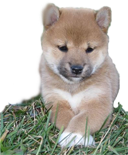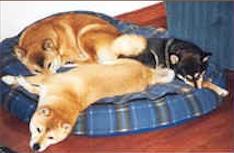 |
The smallest of the Japanese native breeds, the Shiba Inu was originally developed for hunting in the dense undergrowth of Japan's mountainous areas. |
His frame is compact with well developed muscles and he possesses a double coat that can be black and tan, red or red sesame.
![]()
In the fall of 1995 our love for the Shiba Inu began with one small black and tan female we named Mitsu. We were hoping to find a nice small indoor dog for our family and noticed the breed in the "Dogs in Canada" Magazine. When I initially viewed the picture, I was sure this was a large dog. After reading the description I was surprised to learn they fit our size requirements perfectly.
Mitsu was unlike any previous breed I had been familiar with. Her characteristics took owning a dog to another level. House training was not an effort. She was very intuitive and did not have any dog odor. We fell in love with the breed and decided to add a Shiba Inu male and female a year later. We have only bred Shibas. They are very unique and although not for everyone, it is difficult to own another breed once you've been 'owned by' a Shiba.
Our kennel was registered with the Canadian Kennel Club in 1998. We are now Permanently Registered with the Canadian Kennel Club. When we plan a breeding we have a specific goal in mind and often keep a puppy from the combination to further our line. Characteristics we choose are confidence-mental soundness, ideal Japanese Shiba Inu conformation, excellent coat quality/color and sound health. Pedigree is also closely studied prior to breeding to ensure the offspring are not in-bred. After World War II, the Shiba was saved from near extinction using very few dogs who were thought to be pure-bred. Ten dogs were identified as the most influential in forming todays Shiba. They were, Ishi, Koro, Aka (prewar) and Naka, Nakaichi, Matsumaru, Meiho, Kurata no Ishi, Hideyoshi and Tenko. Of the ten, Aka and Naka are considered the most important. Shibas descend from a very small genetic pool. In 1993 the American Kennel Club accepted the Shiba Inu into its non-sporting group. We are located in the Boise Idaho, USA area.
Books I recommend to learn more about the breed are 'The Complete Shiba' and 'The Total Shiba'.
We are members of the National Shiba Club of America (USA), Beikoku Shiba Inu Aikokai (USA) and Nihonken Hozonkai (Japan).
Complete the "Find out more about our kennel" information (top right) to learn more about us. We look forward to hearing from you.

